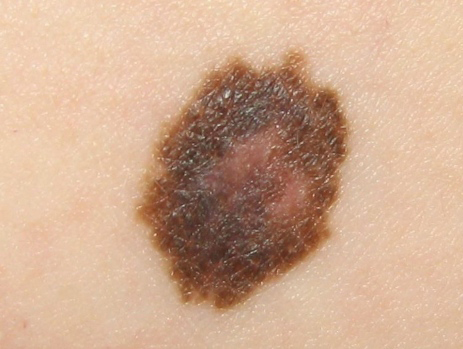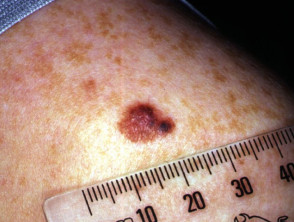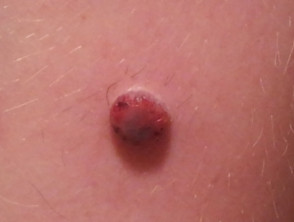However this doesnt mean that its not important to take proper care in order to prevent it or to protect the skin. The Royal Marsden has extensive expertise with melanoma and offers a full range of diagnosis treatment and care services for melanoma in children and young people at its hospital in Sutton Surrey in conjunction with St Georges Hospital London.
Melanoma arising in children has been classified into the following types 3.

Melanoma in children. Melanoma happens when melanocytes stop working normally. Studies reveal that many childhood melanomas bleed or. Melanoma is more likely to invade nearby tissues and spread to other parts of the body than other types of skin cancer.
Melanoma present at birth congenital melanoma Melanoma developing in congenital melanocytic naevus brown birthmark Melanoma arising in patients with dysplastic or atypical naevi most often superficial spreading. Melanoma in Children and Teens Melanoma is a highly malignant skin cancer that begins in melanocytes cells that make the pigment melanin which gives our skin its color of normal skin or moles and spreads rapidly and widely. Even though melanoma is rare it is the most common skin cancer in children.
Research shows that sun exposure and tanning beds increase risk. Melanoma is a significant public health problem in the United States with an estimated 62190 new cases of invasive melanoma and 7910 deaths attributable to melanoma in 2006. Several preexisting conditions increase the risk of development of melanoma during childhood.
In the population of adolescents and young adults age 15-39 years melanoma is the third most common cancer only behind lymphoma and breast cancer. In children age 0-14 years most primary lesions are thick and atypical amelanotic simulating pyogenic granuloma. Melanoma in children and adolescents isnt one of the most frequent illnesses.
Bleeding or itchy spot or growth. 1 Melanoma is uncommon in teenagers and rare in younger children. Pediatric melanoma usually defined as melanoma occurring in patients younger than 20 years is rare representing approximately only 1 to 4 percent of all melanomas 12.
There are different types of treatment for children with intraocular melanoma. Kids who are born with melanocytic nevi large black spots and specific kinds of moles have a risk of melanoma. Are diagnosed with melanoma each year.
Difficulties in histologic diagnosis combined with a reluctance on the p. It occurs more often in adolescents aged 15 to 19 years. The Centers for Disease Control and Prevention estimated 475 new cases of melanoma in the United States in 2002 for persons 19.
It often appears as a small collection of. These include giant congenital melanocytic nevi the familial dysplastic nevus syndrome and xeroderma pigmentosum. 33637 Current research shows that melanoma location is relatively equally distributed across the body for children children of age 04 years have a slightly lower incidence of truncal melanoma.
It primarily occurs in adults but about 300 children in the US. Because of a genetic change mutation they begin growing out. Three types of standard treatment are used.
Pediatric melanoma is becoming more common especially in teenage girls. Melanoma is very rare in children but becomes more common during adolescence and young adult life. The role of small congenital lesions and sporadic dysplastic nevi in the development of melanoma in.
Because of its rarity the biology and clinical behavior as well as the histopathologic features of pediatric melanoma are. Melanoma is curable if caught early enough which is why regular examinations and preventative measures are key. Pediatric melanoma is the most common skin cancer in children.
Sometimes melanoma begins in an area where there is no dark spot or bump. In children melanoma can be one single color and it may not be black or brown. In fact children whove had more than three severe burns during childhood are at greater risk of developing melanoma in the future.
Exposure to ultraviolet UV radiation from the sun and a history of. When a child gets melanoma sun exposure is usually not the cause. Melanoma becomes more common as children get older and it accounts for about 8 of cancers in teens.
Previously it was believed that younger children present with later stage lesions that are more likely to appear on the head and neck. Children with intraocular melanoma should have their treatment planned by a team of doctors who are experts in treating childhood cancer. Conventional melanoma CM or adult-type melanoma.
Four cases of malignant melanoma in children younger than 17 years of age are presented. Fair-skinned light-haired children are at a higher risk for pediatric melanoma. The most like adult melanoma in terms of its causes and risk.
When melanoma starts in the skin it is called cutaneous melanoma. Melanoma is a form of cancer caused by the mutation or pigment-producing cells in the skin. Melanoma is occasionally found in newborns.
The symptoms for pediatric melanoma differ from those found in adults. The most common type of melanoma in children. To give a child the ominous diagnosis of malignant melanoma is a very difficult decision for both clinician and pathologist.
Although melanoma is rare in children it is the most common pediatric skin cancer. Children with melanoma may have one of three different types.
 Skin Cancer In Children Toronto Dermatology Centre
Skin Cancer In Children Toronto Dermatology Centre
 Malignant Melanoma And Deep Penetrating Naevus Difficulties In Diagnosis In Children Journal Of Plastic Reconstructive Aesthetic Surgery
Malignant Melanoma And Deep Penetrating Naevus Difficulties In Diagnosis In Children Journal Of Plastic Reconstructive Aesthetic Surgery

 Malignant Melanoma In Children Not As Rare As Once Thought American Academy Of Pediatrics
Malignant Melanoma In Children Not As Rare As Once Thought American Academy Of Pediatrics
 Pdf The Expression Of Melanoma Inhibitory Activity On Mast Cells In Child Patients With Cutaneous Mastocytosis Semantic Scholar
Pdf The Expression Of Melanoma Inhibitory Activity On Mast Cells In Child Patients With Cutaneous Mastocytosis Semantic Scholar
 Lethal Melanoma In Children A Clinicopathological Study Of 12 Cases Semantic Scholar
Lethal Melanoma In Children A Clinicopathological Study Of 12 Cases Semantic Scholar
 A Single Institution Assessment Of Superficial Spreading Melanoma Ssm In The Pediatric Population Molecular And Histopathologic Features Compared With Adult Ssm Sciencedirect
A Single Institution Assessment Of Superficial Spreading Melanoma Ssm In The Pediatric Population Molecular And Histopathologic Features Compared With Adult Ssm Sciencedirect
Melanoma Ohio Skin Care Institute





No comments:
Post a Comment
Note: Only a member of this blog may post a comment.